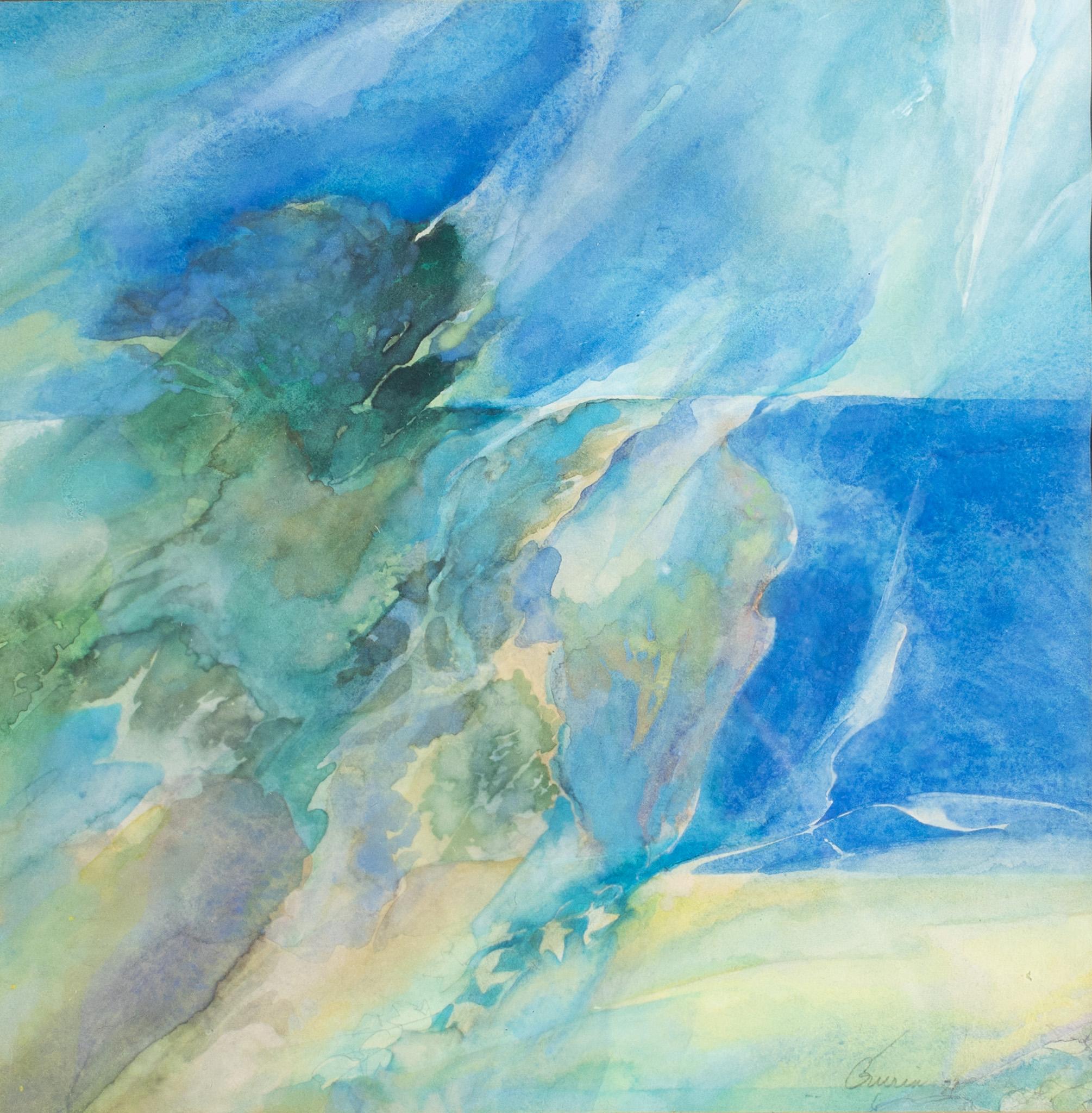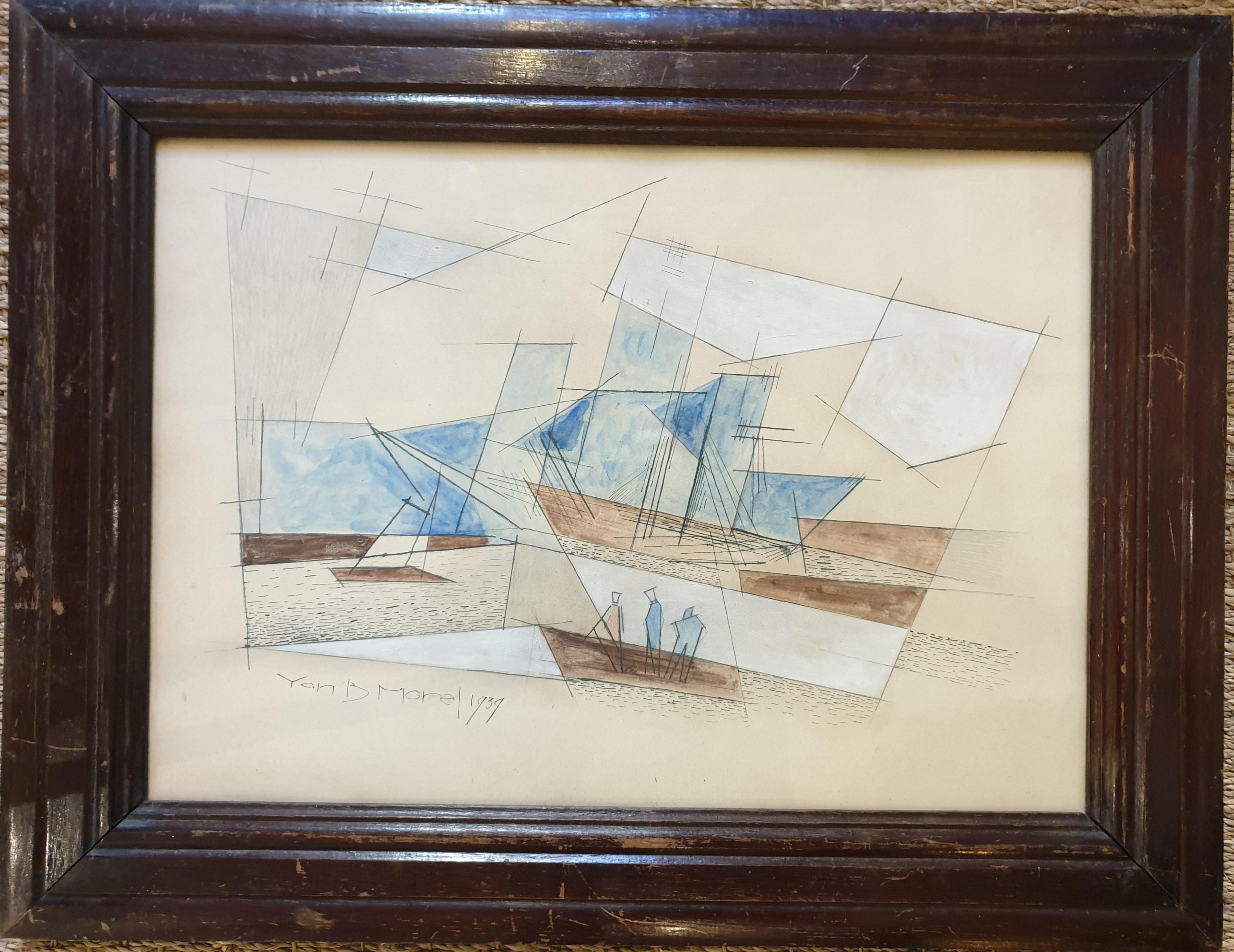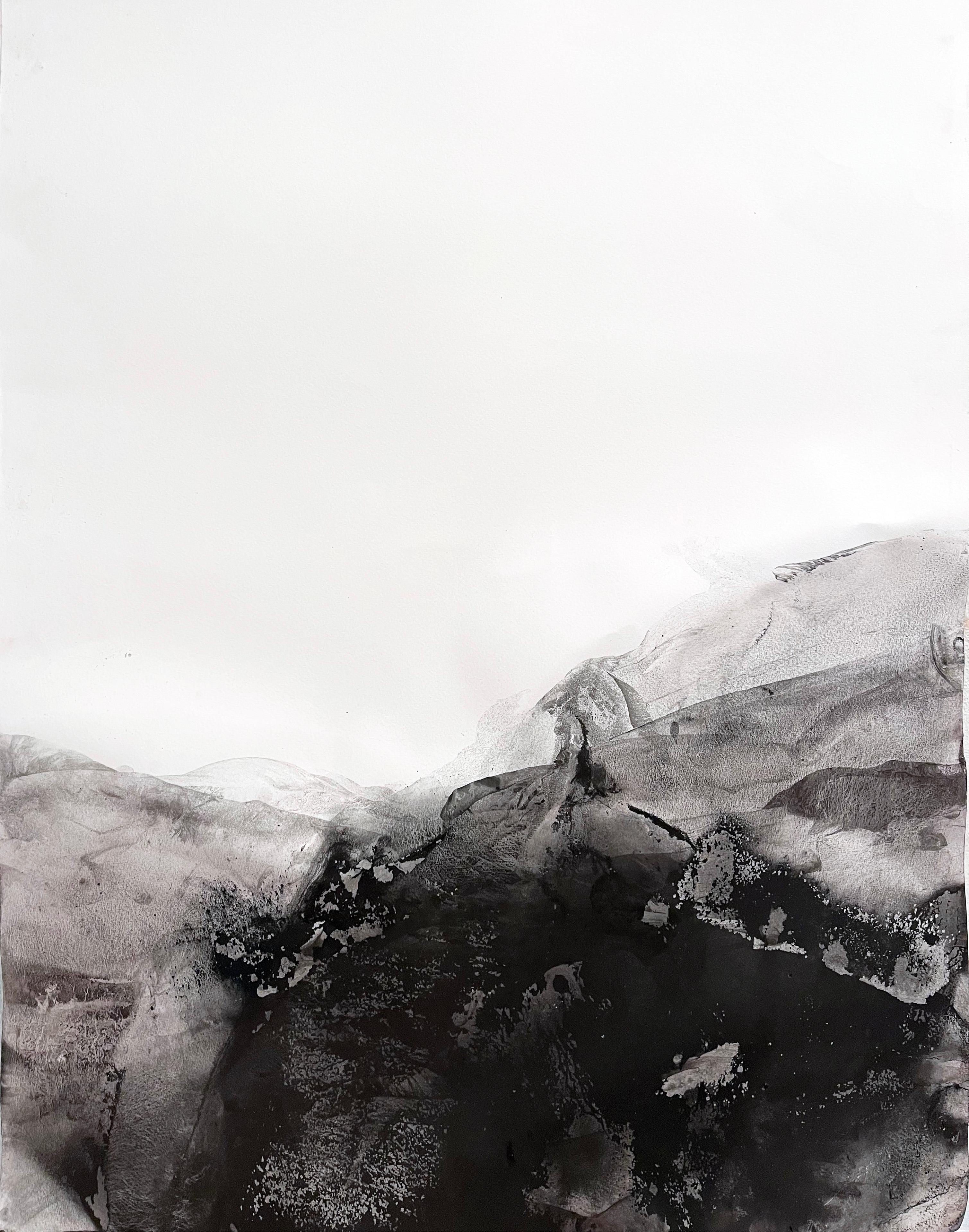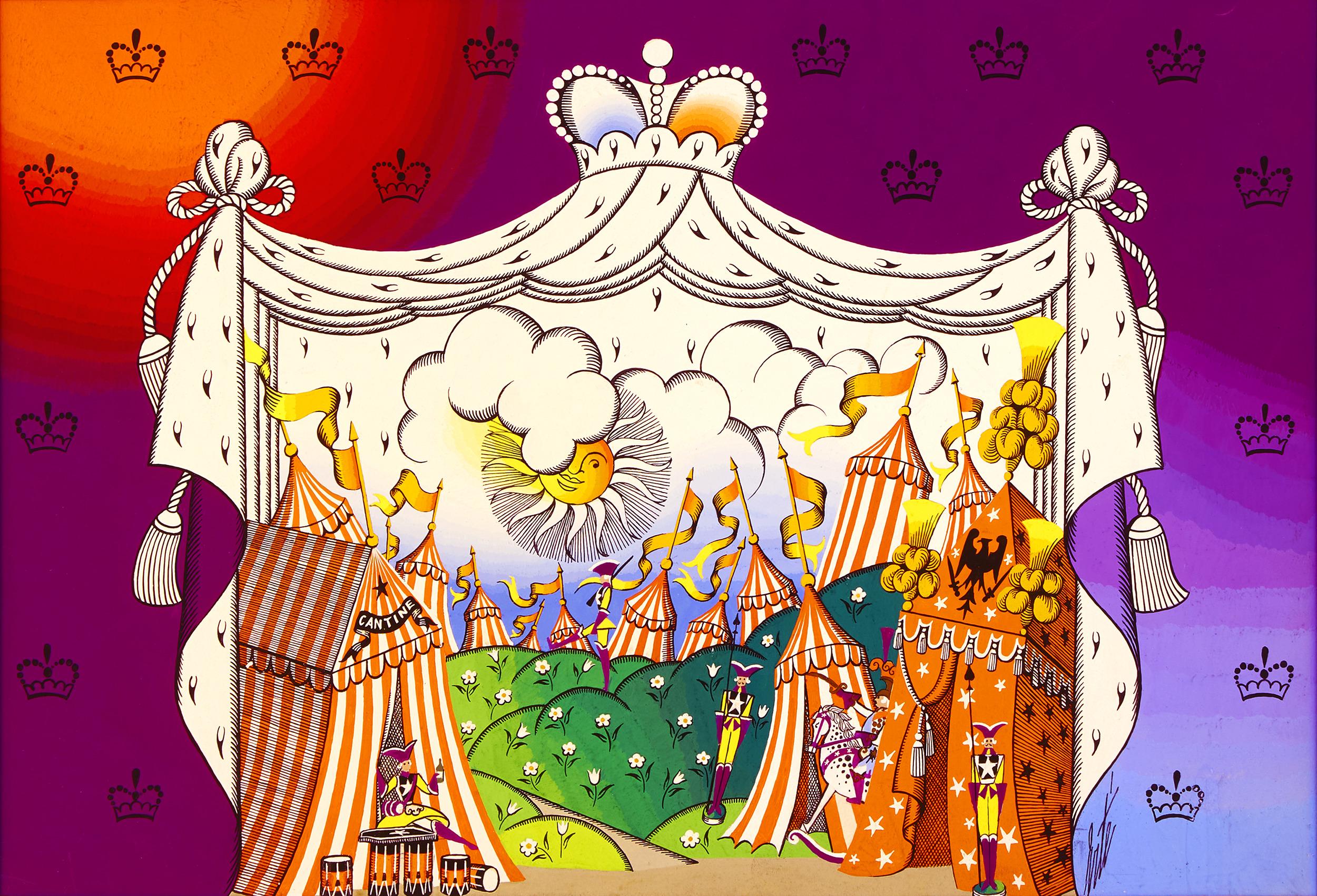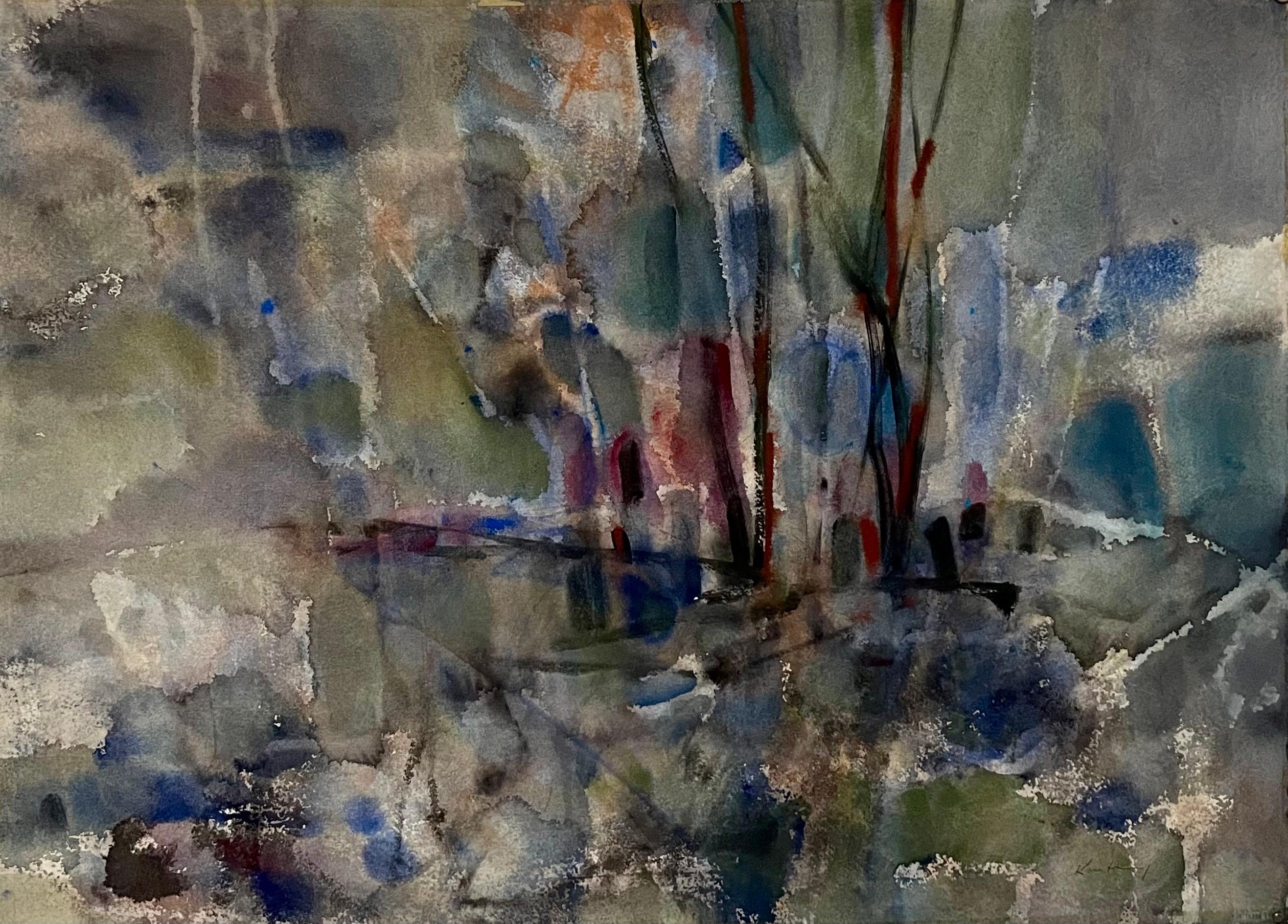Items Similar to Fauvist Watercolor Landscape with Weeping Willow Tree
Want more images or videos?
Request additional images or videos from the seller
1 of 9
Les AndersonFauvist Watercolor Landscape with Weeping Willow Treecirca 1980
circa 1980
About the Item
Vivid, imaginative colors whirl and swirl together to form this whimsical Fauvist abstracted landscape watercolor, featuring a beautiful weeping willow tree, by Les Anderson (American, 1928-2009). Signed "LES ANDERSON" in the lower right corner. From the estate of Les Anderson in Monterey, California. No frame.
Les (Leslie Luverne) Anderson(American, 1928-2009) owned and operated the Bear Flag Gallery in San Juan Bautista, California for many years and was known for his plein air watercolor paintings and abstracts. Les studied at the Minneapolis School of Art and the Art Center at Los Angeles.
- Creator:Les Anderson (1928 - 2009, American)
- Creation Year:circa 1980
- Dimensions:Height: 14 in (35.56 cm)Width: 20 in (50.8 cm)Depth: 0.03 in (0.77 mm)
- Medium:
- Movement & Style:
- Period:
- Condition:Tear on the left edge has been professionally repaired.
- Gallery Location:Soquel, CA
- Reference Number:
About the Seller
4.9
Platinum Seller
These expertly vetted sellers are 1stDibs' most experienced sellers and are rated highest by our customers.
Established in 1986
1stDibs seller since 2014
2,520 sales on 1stDibs
Typical response time: <1 hour
- ShippingRetrieving quote...Ships From: Soquel, CA
- Return PolicyA return for this item may be initiated within 14 days of delivery.
More From This SellerView All
- Autumn Forest - Mid Century Abstracted Fauvist LandscapeBy Emily Shotwell Goeller-WoodLocated in Soquel, CAGorgeous mid century fauvist watercolor landscape with lush, vivid trees and distant houses by Emily Shotwell Goeller-Wood (American, 1887-1965). Presented in a rustic giltwood frame...Category
1940s Fauvist Abstract Drawings and Watercolors
MaterialsWatercolor, Paper
- Early 20th Century Fauvist Abstracted LandscapeBy Charles Henry HarmonLocated in Soquel, CAA colorful, expressive fauvist watercolor landscape of a pond in the forest (Pan Pacific Exposition Palace Ruins) by Charles Henry Harmon(American, 1895-1936). Presented in a giltwoo...Category
1920s Abstract Impressionist Landscape Drawings and Watercolors
MaterialsPaper, Watercolor
- "Domus Series" - Abstract Geometric Futuristic Neon LandscapeLocated in Soquel, CAA bright neon futuristic geometric landscape, depicting a detailed imaginative deconstructive dome structure in a polychrome world, titled "Domus Series" by Anita Margrill (American,...Category
1980s Abstract Geometric Landscape Drawings and Watercolors
MaterialsWatercolor, Archival Paper
- Wyoming Mountains, Modern Abstract Geometric Landscape WatercolorBy Erle LoranLocated in Soquel, CAWyoming Mountains, Modern Abstract Geometric Landscape Watercolor Energetic modern abstract watercolor in blue and orange hues, by Erle Loran (Ame...Category
1980s Abstract Expressionist Abstract Drawings and Watercolors
MaterialsPaper, Watercolor
- Chrysanthemums & Colorful Abstract - Two Sided WatercolorBy Les AndersonLocated in Soquel, CADouble-sided watercolor of pink chrysanthemums along a tree branch and a colorful abstract on verso by Les (Leslie Luverne) Anderson (American, 1928-2009). From the estate of Les And...Category
1980s American Impressionist Landscape Drawings and Watercolors
MaterialsPaper, Watercolor
- Sky & Surf - Abstracted Watercolor Landscape with BirdsBy Les AndersonLocated in Soquel, CAExpressive watercolor landscape of an abstracted crashing surf swirling into a dreamy sky, punctuated by silhouetted birds in flight by Les (Leslie Luverne) Anderson (American, 1928-...Category
1980s American Impressionist Abstract Drawings and Watercolors
MaterialsPaper, Watercolor
You May Also Like
- "Abstract Landscape" Watercolor PaintingBy John GuerinLocated in Austin, TXAbstract landscape resembling a blue, green, yellow, and white. This piece is painted with watercolor and measuring 13" x 13". The frame measures 22" x 24".Category
1970s Abstract Abstract Drawings and Watercolors
MaterialsWatercolor, Archival Paper
- Late Art Deco Period Cubist Nautical Harbour SceneLocated in Cotignac, FRLate Art Deco Period, Cubist watercolour of a nautical harbour scene painted by Yan Bernard Morel (dit Yan Bernard Dyl ) in 1939. Yan B. Morel, born on June 18th 1887, was a French painter, landscape designer, decorator, illustrator and film maker. Morel was a friend of Robert Delauney...Category
1930s Cubist Abstract Drawings and Watercolors
MaterialsPaper, Watercolor, Carbon Pencil
- "Landscape" Seascape - Large Size -Contemporary Drawing- Made in ItalyBy Marilina MarchicaLocated in Agrigento, AGlandscape mineral oxide on papers ( Canson Paper 300gr) 75 x110 cm framed artwork, white wood frame, 91X122 cm the edge of the frame is 3.5c m Ready to Hang 2022 Artwork published ...Category
2010s Contemporary Landscape Drawings and Watercolors
MaterialsCharcoal, Gouache, Paper
- Acte I, La Grande Duchesse By ErtéBy Erte - Romain de TirtoffLocated in New Orleans, LAErté (Romain de Tirtoff) 1892-1990 | Russian-French Acte I, La Grande Duchesse Signed “Erté” (lower right) Inscribed "La Traviata / 1er acte / Entrée des invités / Composition orig...Category
20th Century Art Deco Abstract Drawings and Watercolors
MaterialsPaper, Gouache
- Modernist Abstract Expressionist Watercolor Painting Bauhaus Weimar Pawel KontnyBy Pawel KontnyLocated in Surfside, FLAbstract watercolor composition bearing the influence of the earlier color-block compositions of Paul Klee. Pawel August Kontny, (Polish-German-American artist) He was born in Laurahuette, Poland, in 1923, the son of a wealthy pastry shop owner. In 1939 he began studying architecture in Breslau where he was introduced to the European masters and to the work of some of the German Expressionists, soon afterward banned as "degenerate artists" and removed from museums throughout Germany by the Nazi regime. His studies were interrupted by World War II. Drafted into the German army, traveling in many countries as a soldier, he sketched various landscapes but in 1945, he was captured and held as a prisoner of war in Italy. After the war, he studied at the Union of Nuremberg Architects to help design buildings to replace ones destroyed in the war. He recorded his impressions of the local population and the landscapes through his watercolors and drawings. Pawel Kontny thereafter moved to Nuremberg, Germany, becoming a member of the Union of Nuremberg Architects and helping to rebuild the city's historic center. He soon decided to concentrate on his professional art career. He married Irmgard Laurer, a dancer with the Nuremberg Opera. Pavel Kontny 's career as an artist was launched with his participation in an all German exhibition, held at the Dusseldorf Museum in 1952. He held one-man shows in Germany, Switzerland and the United States. During his trip to the United States in 1960, Kontny became instantly enamored with Colorado, and decided to relocate to Cherry Hills with his wife and two children. He quickly established himself in the local art community, being affiliated for a time with Denver Art Galleries and Saks Galleries. His subject matter became the Southwest. During this time he received the Prestigious Gold Medal of the Art Academy of Rome. His extensive travel provided material for the paintings he did using his hallmark marble dust technique. he also worked equally in pastel, watercolor, charcoal and pencil-and-ink. in a style which merged abstraction and realist styles, influenced by Abstract Expressionist painting and South Western American landscapes. This one bears the influence of Sam Francis. In the early 1960s he was one of only a few European-born professional artists in the state, a select group that included Herbert Bayer (1900-1985), a member of the prewar Bauhaus in Weimar and Dessau, Germany, and Roland Detre (1903-2001), a Hungarian modernist painter. As a Denver, Colorado resident, Pavel Kontny exhibited at galleries and museums throughout the United States, Germany and Japan. There, he was inspired by frequent trips to Native American pueblos in the Southwest, as well as by the study of the Plains Indians of Montana and Wyoming. Over the years Kontny had a number of students and generously helped young artist by hosting exhibitions at his Cherry Hills home. For many years he generously donated his paintings to support charitable causes in Denver. Influences during his European years included German pastelist C.O. Muller, German Informel painter Karl Dahmen and Swiss artist, Hans Erni. In the early 1950s his painting style showed the influence of the Die Brücke (The Bridge), a group of German expressionist artists formed in Dresden in 1905 who had a major impact on the evolution of modern art in the twentieth century in Germany. By the middle of the decade his style incorporated more referential abstraction and total abstraction, resulting in part from his study of Hans Hartung, a German artist based in Paris who exhibited his gestural abstract work in Germany. The American moon landing in 1969 inspired Paul Kontny...Category
20th Century American Modern Abstract Drawings and Watercolors
MaterialsWatercolor, Archival Paper
- Modernist Abstract Expressionist Watercolor Painting Bauhaus Weimar Pawel KontnyBy Pawel KontnyLocated in Surfside, FLAbstract watercolor composition bearing the influence of the earlier color-block compositions of Paul Klee. Pawel August Kontny, (Polish-German-American artist) He was born in Laurahuette, Poland, in 1923, the son of a wealthy pastry shop owner. In 1939 he began studying architecture in Breslau where he was introduced to the European masters and to the work of some of the German Expressionists, soon afterward banned as "degenerate artists" and removed from museums throughout Germany by the Nazi regime. His studies were interrupted by World War II. Drafted into the German army, traveling in many countries as a soldier, he sketched various landscapes but in 1945, he was captured and held as a prisoner of war in Italy. After the war, he studied at the Union of Nuremberg Architects to help design buildings to replace ones destroyed in the war. He recorded his impressions of the local population and the landscapes through his watercolors and drawings. Pawel Kontny thereafter moved to Nuremberg, Germany, becoming a member of the Union of Nuremberg Architects and helping to rebuild the city's historic center. He soon decided to concentrate on his professional art career. He married Irmgard Laurer, a dancer with the Nuremberg Opera. Pavel Kontny 's career as an artist was launched with his participation in an all German exhibition, held at the Dusseldorf Museum in 1952. He held one-man shows in Germany, Switzerland and the United States. During his trip to the United States in 1960, Kontny became instantly enamored with Colorado, and decided to relocate to Cherry Hills with his wife and two children. He quickly established himself in the local art community, being affiliated for a time with Denver Art Galleries and Saks Galleries. His subject matter became the Southwest. During this time he received the Prestigious Gold Medal of the Art Academy of Rome. His extensive travel provided material for the paintings he did using his hallmark marble dust technique. he also worked equally in pastel, watercolor, charcoal and pencil-and-ink. in a style which merged abstraction and realist styles, influenced by Abstract Expressionist painting and South Western American landscapes. This one bears the influence of Sam Francis. In the early 1960s he was one of only a few European-born professional artists in the state, a select group that included Herbert Bayer (1900-1985), a member of the prewar Bauhaus in Weimar and Dessau, Germany, and Roland Detre (1903-2001), a Hungarian modernist painter. As a Denver, Colorado resident, Pavel Kontny exhibited at galleries and museums throughout the United States, Germany and Japan. There, he was inspired by frequent trips to Native American pueblos in the Southwest, as well as by the study of the Plains Indians of Montana and Wyoming. Over the years Kontny had a number of students and generously helped young artist by hosting exhibitions at his Cherry Hills home. For many years he generously donated his paintings to support charitable causes in Denver. Influences during his European years included German pastelist C.O. Muller, German Informel painter Karl Dahmen and Swiss artist, Hans Erni. In the early 1950s his painting style showed the influence of the Die Brücke (The Bridge), a group of German expressionist artists formed in Dresden in 1905 who had a major impact on the evolution of modern art in the twentieth century in Germany. By the middle of the decade his style incorporated more referential abstraction and total abstraction, resulting in part from his study of Hans Hartung, a German artist based in Paris who exhibited his gestural abstract work in Germany. The American moon landing in 1969 inspired Paul Kontny...Category
20th Century American Modern Abstract Drawings and Watercolors
MaterialsWatercolor, Archival Paper
Recently Viewed
View AllMore Ways To Browse
California Landscape Watercolor
California Landscape Watercolor Paintings
Plein Air Tree
Whimsical Watercolors
Willow Tree
Weeping Willow
San Juan Landscape
Bear Flag
Willow Painting
Weeping Willow Art
Willow Tree Painting
Weeping Willow Painting
Weeping Willow Tree Painting
Charles Buckler
Jan Pieter Verdussen On Sale
Submarine Door
Tate Desk
Augustus Lamplough

